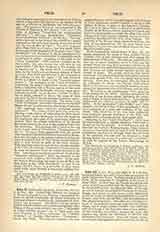

Felix II, POPE (more properly ANTIPOPE), 355-58; d. November 22, 365. In 355 Pope Liberius was banished to Bercea in Thrace by the Emperor Constantius because he upheld tenaciously the Nicene definition of faith and refused to condemn St. Athanasius of Alexandria. The Roman clergy pledged itself in solemn conclave not to acknowledge any other Bishop of Rome while Liberius was alive (“Marcellini et Fausti Libellus precum”, no. 1: “Quae gesta sunt inter Liberium et Felicem episcopos” in “Collectio Avellana”, ed. Gunther; Hieronymus, “Chronicon”, ad an. Abr. 2365). The emperor, however, who was supplanting the exiled Catholic bishops with bishops of Arian tendencies, exerted himself to install a new Bishop of Rome in place of the banished Liberius. He invited to Milan Felix, archdeacon of the Roman Church; on the latter’s arrival, Acacius of Caesarea succeeded in inducing him to accept the office from which Liberius had been forcibly expelled, and to be consecrated by Acacius and two other Arian bishops. The majority of the Roman clergy acknowledged the validity of his consecration, but the laity would have nothing to do with him and remained true to the banished but lawful pope.
When Constantius visited Rome in May, 357, the people demanded the recall of their rightful bishop Liberius, who, in fact, returned soon after signing the third formula of Sirmium. The bishops, assembled in that city of Lower Pannonia, wrote to Felix and the Roman clergy advising them to receive Liberius in all charity and to put aside their dissensions; it was added that Liberius and Felix should together govern the Church of Rome. The people received their legitimate pope with great enthusiasm, but a great commotion arose against Felix, who was finally driven from the city. Soon after, he attempted, with the help of his adherents, to occupy the Basilica Julii (Santa Maria in Trastevere), but was finally banished in perpetuity by unanimous vote of the Senate and the people. He retired to the neighboring Porto, where he lived quietly till his death. Liberius permitted the members of the Roman clergy, including the adherents of Felix, to retain their positions. Later legend confounded the relative positions of Felix and Liberius. In the apocryphal “Acta Felicis” and “Acta Liberii”, as well as in the “Liber pontificalis”, Felix was portrayed as a saint and confessor of the true Faith. This distortion of the true facts originated most probably through confusion of this Felix with another Felix, a Roman martyr of an earlier date.
According to the “Liber Pontificalis“, which may be registering here a reliable tradition, Felix built a church on the Via Aurelia. It is well known that on this road was buried a Roman martyr, Felix; hence it seems not improbable that apropos of both there arose a confusion (see Pope St. Felix I) through which the real story of the antipope was lost and he obtained in local Roman history the status of a saint and a confessor. As such he appears in the Roman Martyrology on July 29.
J. P. KIRSCH

